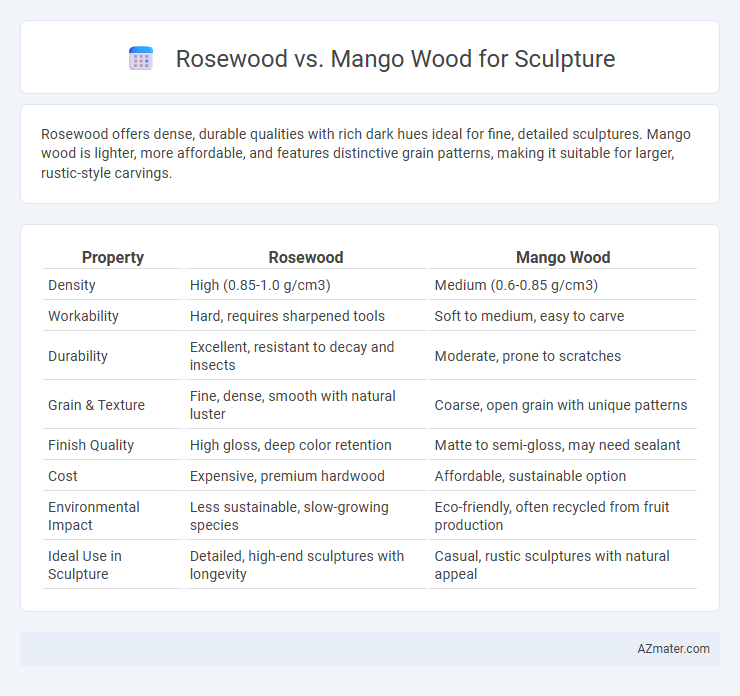Rosewood offers dense, durable qualities with rich dark hues ideal for fine, detailed sculptures. Mango wood is lighter, more affordable, and features distinctive grain patterns, making it suitable for larger, rustic-style carvings.
Table of Comparison
| Property | Rosewood | Mango Wood |
|---|---|---|
| Density | High (0.85-1.0 g/cm3) | Medium (0.6-0.85 g/cm3) |
| Workability | Hard, requires sharpened tools | Soft to medium, easy to carve |
| Durability | Excellent, resistant to decay and insects | Moderate, prone to scratches |
| Grain & Texture | Fine, dense, smooth with natural luster | Coarse, open grain with unique patterns |
| Finish Quality | High gloss, deep color retention | Matte to semi-gloss, may need sealant |
| Cost | Expensive, premium hardwood | Affordable, sustainable option |
| Environmental Impact | Less sustainable, slow-growing species | Eco-friendly, often recycled from fruit production |
| Ideal Use in Sculpture | Detailed, high-end sculptures with longevity | Casual, rustic sculptures with natural appeal |
Introduction to Rosewood and Mango Wood
Rosewood and mango wood are popular choices for sculpture due to their distinct qualities and aesthetic appeal. Rosewood is known for its rich, dark hues, dense grain, and natural oils that provide durability and a smooth finish, making it ideal for fine, detailed carvings. Mango wood offers a lighter, more sustainable option with a softer texture, warm tones, and unique grain patterns that enhance rustic and contemporary sculptures.
Botanical Origins and Growth Habits
Rosewood, derived primarily from Dalbergia species native to tropical regions of Central and South America, India, and Southeast Asia, features dense, hard wood with dark, rich hues ideal for detailed sculpture. Mango wood, sourced from the Mangifera indica tree native to South Asia, grows rapidly and exhibits a softer, less dense grain with lighter tones and unique markings, making it suitable for larger, less intricate carvings. Understanding the botanical origins and growth habits of rosewood and mango wood highlights their distinct physical properties and suitability for various sculptural applications.
Physical Properties and Appearance
Rosewood is dense and heavy with a fine, even grain, offering a deep reddish-brown color that darkens with age, making it ideal for detailed sculpting and a polished finish. Mango wood, lighter and softer than rosewood, features a varied grain pattern with golden to yellowish-brown hues, which provide a warm and rustic look but may be less durable for intricate sculpture work. Rosewood's hardness and natural oils resist cracking and wear better than mango wood, which can be more prone to dents and scratches.
Workability and Carving Ease
Rosewood offers superior density and fine grain, making it ideal for detailed sculpture work requiring precise carving. Mango wood is softer and more pliable, allowing easier shaping and smoother cuts but may lack the durability needed for intricate designs. Artists seeking a balance between durability and ease often choose mango wood for rough shapes and rosewood for fine finishing.
Durability and Longevity
Rosewood offers exceptional durability and longevity due to its dense grain structure and natural resistance to decay and insects, making it ideal for intricate sculptures exposed to varying conditions. Mango wood, while moderately durable, tends to be softer and more prone to wear over time but is valued for its sustainability and lighter weight in artistic carvings. Sculptors seeking long-lasting, high-end pieces often prefer rosewood, whereas mango wood suits projects emphasizing eco-friendliness and ease of carving.
Price Comparison and Availability
Rosewood sculptures generally command higher prices due to the wood's dense grain, rich color, and limited availability linked to strict regulations on logging and trade. Mango wood is more affordable and widely available, sourced from fast-growing trees that are sustainably harvested and commonly found in tropical regions. The cost difference between these woods significantly impacts the final price of sculptures, with rosewood pieces often marketed as premium art due to their rarity and visual appeal.
Environmental Impact and Sustainability
Rosewood and mango wood differ significantly in environmental impact and sustainability for sculpture. Rosewood is often sourced from slow-growing, endangered trees with strict regulations to prevent illegal logging, leading to higher ecological concerns and limited availability. Mango wood, derived from fast-growing, renewable fruit trees, offers a more sustainable option with lower environmental impact due to its use as a byproduct after fruit harvesting.
Suitability for Fine Detailing
Rosewood offers exceptional suitability for fine detailing in sculpture due to its dense grain and smooth texture, allowing artists to achieve sharp, intricate carvings with minimal splintering. Mango wood, while softer and easier to carve, tends to have a coarser grain that may limit the precision of delicate details but provides versatility for larger, more rounded forms. For sculptures requiring high-definition ornamentation and longevity, rosewood remains the preferred choice among artisans seeking fine detail accuracy.
Common Uses in Sculpture Art
Rosewood is prized in sculpture art for its dense, fine grain and rich, dark hues, making it ideal for intricate carvings and detailed ornamental pieces. Mango wood, valued for its sustainability and lighter color, is commonly used in larger sculptures and rustic or contemporary art due to its softer texture and ease of shaping. Artists often choose rosewood for high-end, detailed sculptures while opting for mango wood when creating eco-friendly and sizable artworks.
Choosing the Right Wood for Your Sculpture
Rosewood offers a dense grain and rich color ideal for intricate, durable sculptures with fine details, while mango wood is lighter, more affordable, and eco-friendly, providing versatility and ease of carving. Selecting the right wood depends on factors like project scale, desired finish, and budget constraints, with rosewood suited for high-end, polished pieces and mango wood preferred for larger or rustic designs. Understanding wood hardness, grain pattern, and sustainability helps sculptors achieve optimal results and longevity in their artworks.

Infographic: Rosewood vs Mango Wood for Sculpture
 azmater.com
azmater.com